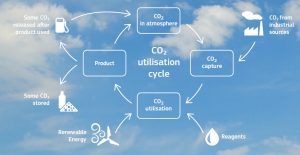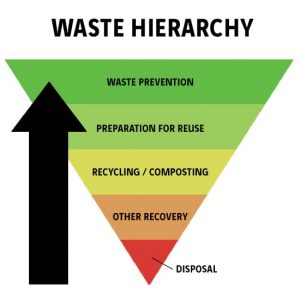John Laurie said, and it was said again by Peter Jackson at our meeting, “We’re doomed, we’re all doomed!” Here in Sheffield it’s really scary with a prediction that Millhouses Park, as well as East Anglia, Lincolnshire, northern Germany, the Low Countries and many other low lying lands around the world will be part of the sea bed by 2100. Stumperlowe should escape, however.
So something drastic needs to be done. There’s a lot of election noise here at the moment, and indeed at a much higher level at the imminent G20 about tackling carbon emissions. Do our politicians have a handle on the scale of the problem and what to do about it?
Peter Styring, Professor of Chemical Engineering and Chemistry at the University of Sheffield, is such an international authority on the subject that politicians and industry are taking him and others in the field very seriously. Peter is Director of the UK Centre for Carbon Dioxide Utilisation and has his own company (CO2Chem Media & Publishing) and has established the Styring Group. He is looking to set up a Brussels office. He has published the influential “Carbon Capture and Utilisation in the Green Economy” and “Carbon Dioxide Utilisation: closing the carbon cycle”. He delivered a stunning lecture to us, but at a cost of a meteoric rise in carbon dioxide (CO2) in the room and confirmed by the numbers on his pocket gasometer at the end. Despite worrying levels of such a narcolepsy-inducing gas-filled air, everyone stayed awake.
Global warming is associated with increasing carbon dioxide levels. Coral reefs are disappearing. Fisheries at low latitude around the world are being lost. Arctic regions are melting. There’s more water and heat in the atmosphere causing weather extremes. Rising water levels lead to coastal flooding. Here in Sheffield, there’s already significant heat related morbidity and mortality resulting in 500 to 700 deaths, largely from particulate matter in the air.
We’re now at the tipping point, so everyone needs to be acutely environmentally and economically aware. To avoid catastrophe, at current emission rates, and to limit a global warming rise of 1.5 degrees C by 2055, global carbon dioxide emissions must by then have reached net zero, starting now. Radiative factors such as methane, nitrous oxide (not a laughing gas matter) and aerosols need to reduce by 2030.
Perversely, wind turbines are not low carbon at all, emitting five per cent of the SF6 (sulphurhexafluoride) which leaks from its casing and is dangerous! SF6 from turbines emit 24000x carbon equivalent of CO2. It’s used as an insulator which prevents arcing.
Internationally (and many countries are dragging their feet), industry must be willing to engage. Carbon capture utilisation (CCU) and storage (CCS) is the only solution. A global carbon price is essential therefore it must be taxed. CCU must be properly subsidised on a level playing field. Vast subsidies to protect jobs are already made to the oil and gas industries. The same is true for CCS projects, yet CCU does not yet attract subsidies. There will need to be a gradual (rather than sudden) transition as a “calmer” to the petrochemical industry.
It was encouraging to hear from Peter that Unilever is now taking CCU all very seriously, with home care products initially but now with a ripple effect on their whole industry.
So what exactly is CCU? This is carbon capture without the need for geological storage. Carbon dioxide from power stations, factories and the atmosphere can be used for the production of fossil oil substitutes, feedstock for farm animals, plastics, surfactants, concrete, biofuel, and aviation fuel. The whole process is carbon neutral and depends on algal photosynthesis (energy from light). Drax use it with their waste water. Another method is conversion into hydrocarbons which can be stored as energy or converted into fuel or plastics. Chemical intermediates from CCU can be processed into pharmaceuticals, health care and consumer products.
The government claims it is committed to deploying CCU, capturing carbon and storage on a long-term basis, but any delay after 2030 will not achieve its aim of complying to a limit of a 1.5 degrees C rise by 2050.

Government planning is short on detail about removal of greenhouse gases and action on CCU and CCS. Neither adequate private investment nor research funding is in place. Clarity is needed. Brexit takes priority at the moment, at the expense of social justice and accountability. For instance, Manchester has promised CO2 emission reduction of 49% by 2025 by means of a Clean Air Zone, more electric vehicles (EV) and CCS. The problem is that EVs are not zero emission and their plans for CCS facilities are unclear. Biomass is not the panacea. It is not carbon neutral. The UK energy mix currently falls far short of the ideal (combined cycle gas turbines 56.2%, open cycle gas turbines 0%, oil 0%, coal 5.9%, nuclear 16.7%, wind 9.7%, pumped storage hydro 0%). If we’re not at net zero by 2029 it will be the tipping point, so the politicians need real policies to back up their political statements. This is a long term game, so serious cross party thinking and decisions are urgently needed. “The world will not evolve past its current crisis by the same thinking that created it” (Einstein – paraphrased)
The Lansing triangle sums up where we need to be – in the green bit at the top, avoiding fossil fuels unless carefully managed. Worst of all is CCS and landfill. Sheffield’s proposed Clean Air Charge is flawed. It cleans up the city centre but defers the problem to the suburbs. The worst emissions are currently already owned by the Station, Abbeydale Road, Ecclesall Road and Broomhill. These will get worse. Other examples of our City Council’s wisdom are the diesel generator for the Ferris wheel at ground level, poisoning all the kids around. Old polluting diesel taxis and buses are a major problem. The solution is an urgent need to “reduce and reuse”. We were advised to hang onto our old diesels as technology is on the way to make them carbon friendly. In the meantime, get a bike.

For the future, e-fuels from CCU are perhaps the most important. CCU isn’t new. The first CCU plant was built by Joseph Priestley at the Leeds brewery in 1772. He invented fizzy drinks (as well as other things).
Carbon found in anything can be extracted as CO2 to utilise it and make it carbon neutral, for instance in extraction of iron from its ore. There are countless synthetic substances which contain carbon. Any of these can be sourced from CCU.
Sustainable agrochemicals can feed the world. Blue urea production has exciting potential as a fertiliser and is truly carbon negative. Furthermore, there are plans to produce it in shipping containers on site at farms where it’s needed. This is a great example of CCU as a renewable commodity-based technology with the capacity to use carbon dioxide emissions in remote locations where there is no opportunity for geological storage.
